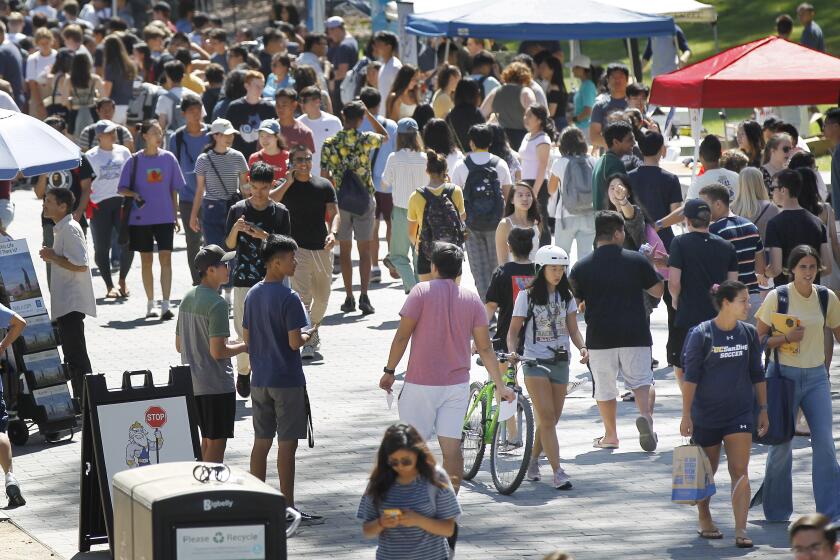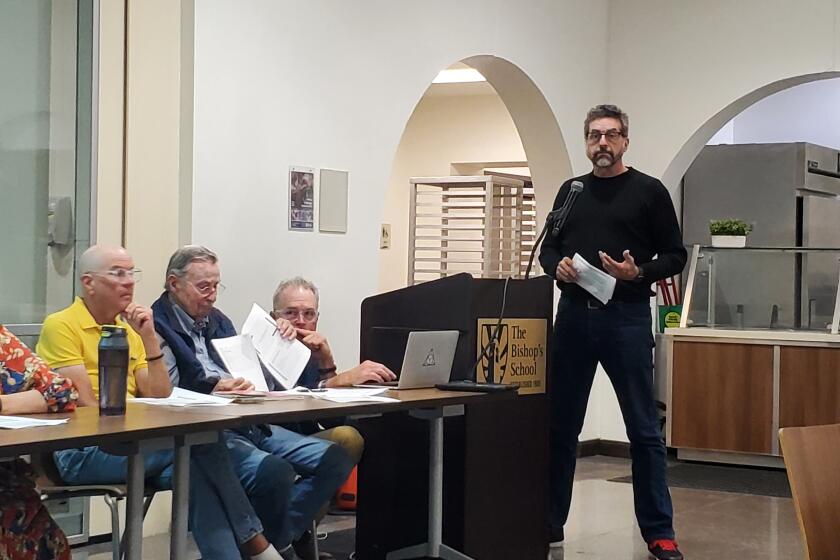‘Slow Down’ La Jolla: Multiple car accidents occur in recent weeks
At least four car accidents have taken place across La Jolla in the month of July and first week of August, prompting different courses of action to draw attention to the issue.
Starting the afternoon of July 10, an elderly driver crashed her white Lexus into a house on the corner of Torrey Pines Road at Ivanhoe Avenue. The driver was briefly trapped in the vehicle and had to be rescued by San Diego fire fighters. The cause of the crash was not confirmed.
The homeowner has since posted two signs in front of the property, facing the heavily trafficked Torrey Pines Road. They read: “Slow Down” and “Please!!! Do Not Crash Into My House Again!”
Ten days later, an elderly female driver was struck by a City trash truck around noon July 20 at the intersection of Girard Avenue at Torrey Pines Road. The driver did not sustain any injuries, but a portion of her car’s front bumper was dislodged. The driver reports she was stopped at the red light at Girard Avenue before turning onto Torrey Pines Road from the first right lane.
The truck was in the second right lane and did not adhere to the “No Turn on Red” sign posted at the intersection. In the process of turning, the truck clipped the car.
The month concluded with an incident in which a bicycle collided with a Lexus turning into a driveway the morning of Saturday, July 29 on the 2500 block of Torrey Pines Road. The cyclist was taken away in an ambulance. According to witness Greg Wiest, who sent photos of the accident to the Light, the Lexus was heading east into the driveway when a bicyclist riding west down Torrey Pines Road saw the car, braked hard but couldn’t avoid crashing into the passenger side, striking his head into the side window. He was wearing a helmet.
Wiest said he lives in the area and that section of Torrey Pines Road is often subject to speedy drivers. “It’s very dangerous for all … there are potholes and visibility is poor in certain areas. By the way, this is the exact spot that a speeding car smashed into the electrical box at 2:30 a.m. last week, knocking out power to our building and surrounding area. Welcome to summer,” he said. The speed limit on the street is 35 miles per hour.
Two crashes, two weeks on one street
In the span of two weeks, two car accidents took place on Cardeno Drive, both of which caused a car to flip onto its side. In both cases, according to a nearby resident (who requested anonymity), a moving vehicle struck a parked vehicle. He wanted to share the story with Light readers.
“I’ve been concerned about the speeds on our street for some time. I have a radar gun and I measure the speeds of cars on a regular basis,” the resident said. “I’ve recorded speeds of up to 50 miles per hour. The speed limit varies between 25 and 30 miles per hour.”
In the most recent accident, on Aug. 3, the driver was reportedly looking down for something on the passenger seat and did not realize the drifting, and so hit the parked car. “Today’s crash damaged my property. It hit a wall on my property and messed it up. The car tore the wheel off the parked car and then veered into my driveway. The wheel ended up half-a-block away,” the resident said. “Two weeks ago, around 9:30 a.m. on July 20, the same thing happened in the same area.”
Cardeno Drive starts east of La Jolla Scenic Drive South (where Nautilus Street ends) and is occasionally used as a detour to get into La Jolla from Pacific Beach. There are no lights on the street and one stop sign at Alta La Jolla.
“There are so many schools in that area (All Hallows Academy, The Evans School and the San Diego French American School) and not very good speed limit signage,” he said. “I don’t think cars notice the signs and come through really fast.”
The resident added that drivers often come up Nautilus Street at an uphill speed and if they make the green light, continue at that speed, despite the speed limit being reduced.
“I walk my dog and when the cars go 50 miles per hour just a few feet from you, it doesn’t feel safe. … If someone was walking on the sidewalk, they could really be hurt,” he said.
The resident would like to see any of the following measures taken to slow speedy drivers: a flashing speed limit indicator sign installed, an illuminated speed limit sign to indicate what the speed limit it, or an officer posted to issue tickets. “Anything that will get a driver’s attention and remind them that the limit is changed,” the resident said, adding that he might attend the La Jolla Traffic & Transportation advisory group meeting 4 p.m. Aug. 16 at the Rec Center.
Police: Pay attention
When it comes to preventing crashes like this, San Diego Police Department Traffic Safety Officer Mark McCullough said the simplest — not necessarily the easiest — rule to follow is simply to pay attention to your driving and your surroundings.
“I know that sounds basic, but driving takes 100 percent of your attention,” he said. “It can be tempting to use the technology we have that distracts us, but paying attention is just the best rule of thumb.”
He said drivers need to be aware of speed limits and changing conditions, because the speed limits were set for a reason. “Once engineers have designed a road and gone through the process to get it built, and looked at the surround conditions such as residential or commercial, the speed limits are set at an appropriate level,” he said. “We ask that drivers maintain the speed limit or go slower.”
However, McCullough added, “In Southern California, we tend to be in a hurry and live in our cars. We are always dropping off a child at school or an activity, rushing to work, getting food at drive-through restaurants and coffee shops. We’ve developed this culture where we wrap ourselves in our cars. People see it as a protective shell, so they act accordingly, which might not be the safest way to go. People think they can get away with a lot more in their cars.”
Factor in cell phones, GPS navigation programs that take drivers into unfamiliar areas and music availability, and he said the amount of technology that tends to distract drivers is at “the next level.” (Friendly reminder: The ticket for hand-holding a cell phone while operating a vehicle is $200.)
“To know what causes crashes and see drivers continuing to do these things, is frustrating,” McCullough said. “These accidents are preventable, just pay attention to your driving. You can always pull over to make a call (with the car off) or take a break. But to see this continue to happen is like beating your head against the wall.”
Get the La Jolla Light weekly in your inbox
News, features and sports about La Jolla, every Thursday for free
You may occasionally receive promotional content from the La Jolla Light.




